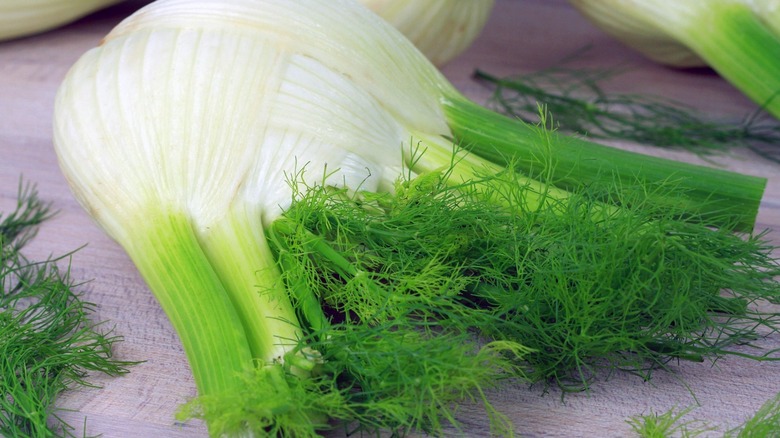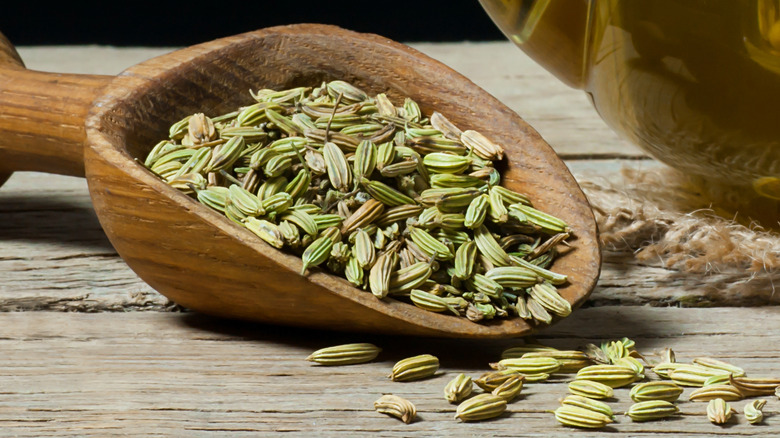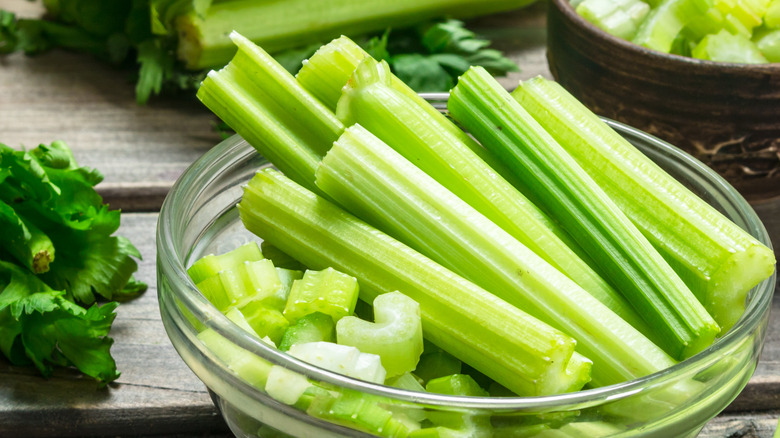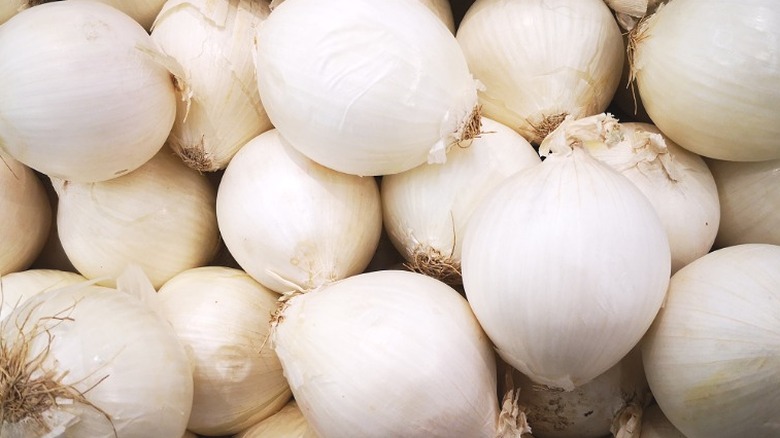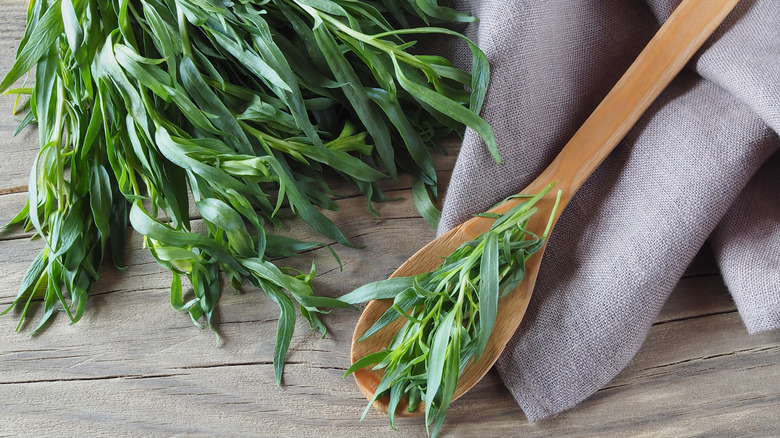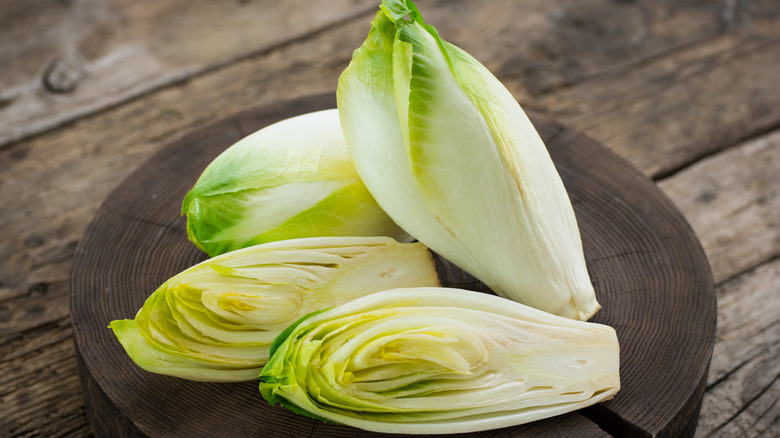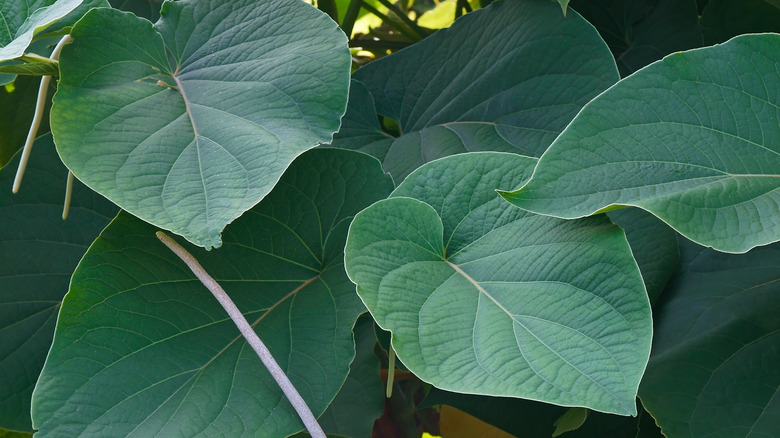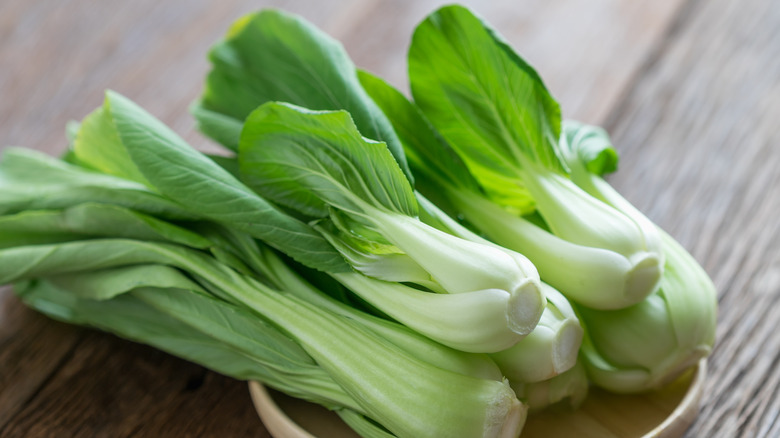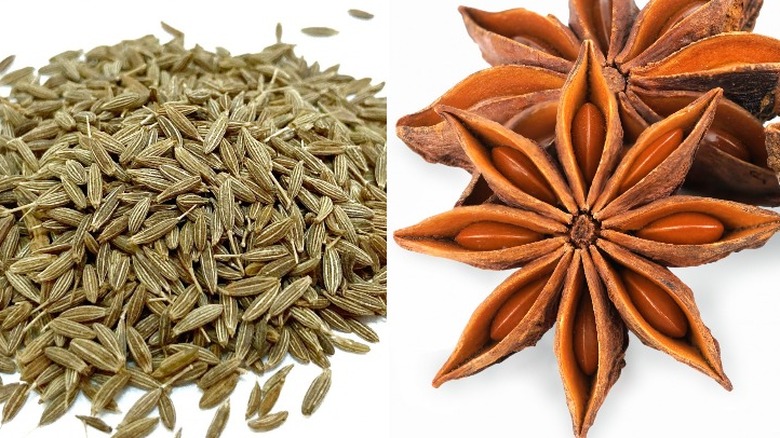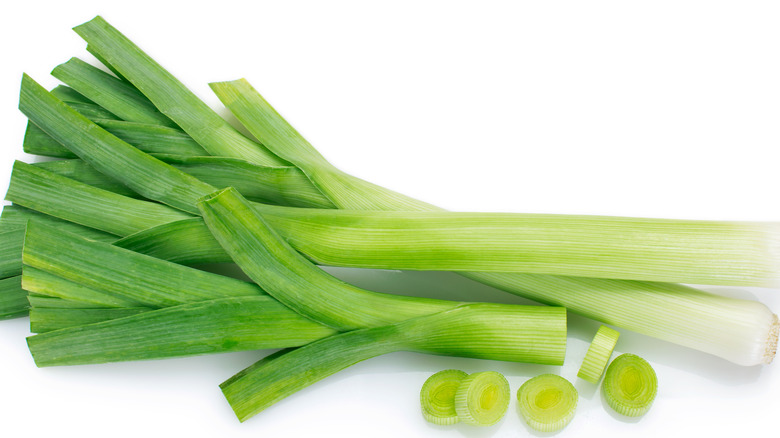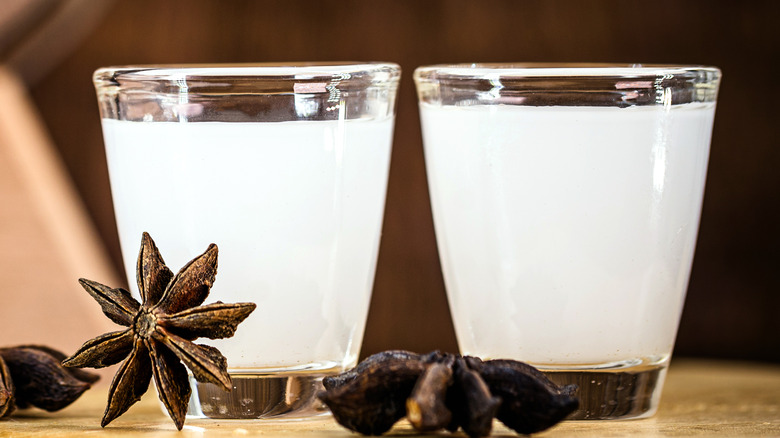10 Best Substitutes For Fennel
The white and green vegetable known as fennel is easy to spot in the produce aisle, both because of its large size and thick stems topped with green fronds. Fennel can be used raw or cooked, making it very versatile, and its distinct flavor sets it apart from other veggies. So what happens when you can't track down any at the store?
According to Eating Well, fennel belongs to the same family as carrots and parsley. It has a large, white bulb, green stalks, and feathery leaves known as fronds. All parts of the fennel plant are edible: the raw bulb and stems are crunchy like celery with a sweetness that recalls apples or carrots. Fennel also has a mild licorice flavor — to be clear, we don't mean red Twizzlers, but old-fashioned black licorice, the kind that people either love or hate! Cooking Light notes that this flavor is most prominent in uncooked fennel; when sautéed or roasted, the flavor gets milder. Fennel's feathery fronds resemble those of dill weed (which is in the same plant family as fennel, according to Britannica) and like dill, they can be chopped and used like fresh herbs.
Here are 10 items you can use as a substitute for fennel. Some mimic the flavor of the vegetable, while others have a more similar texture.
1. Fennel seeds
If the main purpose of including fresh fennel in your dish is to impart a delicate, licorice flavor, then fennel seeds may make a good substitute. Eating Well explains that fennel plants produce flowers, and the seeds are then harvested from these dried flower heads. The seeds are light green or tan in color and bear a strong resemblance to caraway and cumin seeds. They have a sweet, licorice-like flavor similar to that of fresh fennel bulb. Look for fennel seeds in the spice aisle where other dried spices are stocked. Fennel seeds can be purchased whole or ground, although as with most dried spices you'll get a more robust flavor by grinding the whole seeds yourself.
In cooked dishes like pan-fried fish or for savory soups, use ground fennel seeds to add a boost of "earthy" flavor. Fennel seeds can also be used to season homemade dressings. To replace both the flavor and bulk of fennel bulb, Gourmet Sleuth suggests that for a pound of fennel bulb, use one pound of celery along with 1 teaspoon of fennel seed.
2. Celery
Fresh, crisp fennel shines in dishes where you can really appreciate its crunch. That makes celery a good veggie to reach for when no fennel is to be found. Although celery doesn't have the mild licorice flavor, Simply Healthy Family says it does have a very similar texture to sliced fresh fennel. By choosing celery as a fennel substitute, you're keeping things in the family! As Britannica points out, celery and fennel (along with carrots and parsley) are part of the plant family Apiaceae.
Reach for celery when making salads or stir fries that call for fennel. According to The Daring Kitchen, you can sub in the same amount of celery as your recipe calls for of fennel bulb. The celery can be diced to use in sandwich fillings like egg salad or tuna salad. Food & Wine notes that for stuffing recipes calling for fennel, celery is a great substitute. Food.com shares that classic stuffing recipes usually include celery, so the substitution will work very well flavor-wise.
3. Onions
When there's no fresh fennel available, The Daring Kitchen says that you can reach for onion to replace them. Although they don't have the licorice notes fennel is known for, sliced or chopped onions will give your dishes the texture and crunch that would've come from fennel, as well as a flavor boost.
For dishes like salads where the onion will be uncooked, choose mild varieties such as white onions. To replace some of the sweetness lost by omitting fennel, choose red onions or Vidalia sweet onions, both of which are milder and have more sweetness than all-purpose yellow onions. The flavor of onions will be mellower, of course, after they are cooked. (The same is true of fennel.) However, onions will still enhance the overall flavor of your dish, and are worth using in place of fennel in both cooked and raw dishes.
The Daring Kitchen suggests replacing the fennel bulb in your recipe with an equal amount of mild onions.
4. Tarragon
According to Eating Well, the light licorice flavor in fennel is present in all parts of the plant, from the seeds to bulb and even the feathery fronds. Those fronds are often chopped up and added to fresh salads or dressings, which means home cooks can look to other herbs when no fresh fennel fronds are available. The Chef's Pencil suggests trying the herb tarragon, especially in savory recipes for meat and fish, as it has a similar licorice-y flavor.
According to Fine Dining Lovers, tarragon has more going on than just the taste of licorice. This herb is complex, with additional flavors of vanilla, mint, and eucalyptus, and balances its sweetness with a bit of bitterness. A lot of this complexity is lost, however, when the herb is dried; for this reason, professional chefs prefer to use only fresh tarragon.
Look for bunches of the fresh herb in warm months at farm stands and farmer's markets. You may also find it in the produce section of grocery stores where other packaged, fresh herbs are stocked. Using fresh tarragon as a substitute is relatively simple; SPICEography notes that you can use the same amount as you would fennel fronds.
5. Belgian endive
Taste Essence suggests Belgian endive will make a good substitute for fresh fennel, although it does have a different flavor profile. Belgian endive is green with leaves that grow in a tight cylinder. The pale leaves are nice and crisp, similar to the crunch of fresh fennel, and have a distinctive, bitter flavor that works well in dishes that have sweet or sour flavors from other ingredients. Belgian endive is also versatile like fennel: It's delicious both raw and when braised, grilled, or roasted, which provides plenty of chances to offset the bitterness by incorporating other flavors. Another way Belgian endive differs from fennel is that it doesn't have any licorice flavor notes. This can be solved by pairing it with ingredients that do, like fennel seeds or tarragon.
Taste Essence suggests starting with half the amount of Belgian endive — if your recipe calls for a cup of sliced fennel, for example, use half a cup of endive — along with a quarter teaspoon of crushed fennel seeds. This conservative approach will make sure the flavors of the endive work well with your dish. You can always add more endive and crushed fennel seed if you decide they're needed.
6. Hoja santa leaves
Your familiarity with this next fennel substitute may depend upon where you live. If you do have access to it, The Daring Kitchen says that hoja santa leaves are an intriguing option. According to Sow Exotic, this large-leaf herb is native to South America and Mexico; it may also be found in some parts of the southern and southwestern U.S. and can be sold under other names like Mexican pepperleaf, yerba santa, or root beer plant. Hoja santa is part of the same plant family as peppercorns, and its flavor is sometimes described as having a peppery note. Because the leaves have an intriguing flavor — described as licorice-like with notes of eucalyptus, sassafras, and mint — they can be a good substitute for fennel.
To get the truest flavor of hoja santa, look for fresh leaves in Latin grocery stores or vegetable markets, because a lot of the flavor is lost when the leaves are dried. Use the chopped or diced leaves in stews, soups, and sauces. The Daring Kitchen suggests using the same amount of fresh hoja santa leaves as you would fresh fennel.
7. Bok Choy
Another veggie you can check for in the produce aisle when no fennel is to be found, according to The Daring Kitchen, is green and white heads of bok choy. According to Clean Green Simple, bok choy can be similar in size and shape to heads of celery, but has larger, dark green leaves and white ribs.
Bok choy has a firm, crunchy texture like fresh fennel, but this member of the cabbage family is different. It doesn't have fennel's licorice flavor; it's slightly bitter and earthy, and the greens have a spicy flavor similar to mustard greens. Some stores may also carry baby bok choy — a miniature version of regular bok choy — which tends to be a little sweeter.
According to The Daring Kitchen, you can replace fennel in recipes with an equal amount of bok choy, which will bring freshness and crunch to your recipe. Add 1 teaspoon of fennel seeds to give your dish more of a licorice flavor. In addition to using bok choy in fresh dishes, it can also be substituted for fennel in braises, roasts, and stir fries.
8. Anise
For dishes that involve the characteristic licorice flavor of fennel, using the spice anise is a great choice, per Taste Essence. There are two options to choose from: Anise seed or star anise. Gardening Know How shares that the two are often confused for each other — not surprising, given the similar names and the fact that the both have the flavor of licorice! The two herbs actually come from different plants. Anise seed is a member of the same family as fennel, and the plants have tall stems with white flowers. Star anise, on the other hand, are seeds in star-shaped pods that grow on trees native to China. Both anise seed and star anise contain the compound anethole, which gives them their licorice flavor.
Because anise will only replace the licorice flavor of fennel, depending on the recipe you will likely need to pair it with a vegetable that can replace fresh fennel's bulk — consider Taste Essence's recommendation to start with half the amount of an ingredient like celery or bok choy, and then add in a quarter teaspoon of a spice like ground anise. Taste your dish before adding more of these ingredients. If your recipe is one that needs simmering you can also drop a whole star anise pod into the cooking liquid, then scoop it out before serving.
9. Leeks
According to Simply Healthy Family, leeks can be a great choice to use in place of fennel in your recipes, especially soups and baked casseroles. Leeks are a member of the allium plant family along with onions and scallions, but their oniony flavor is more mild. Leeks are easy to spot at the store: The tall, cylindrical stalks go from white at the bottom to pale green, and they're topped with stiff, flat, dark green leaves. If you can find smaller, younger leeks, they'll have an even sweeter and milder onion flavor. Though leeks don't have licorice flavor like fennel does, they do have a nice crunch and pleasant taste when sliced or chopped into fresh dishes. Leeks are also delicious in baked or braised recipes.
A Couple Cooks says that one large leek can be used in place of one fennel bulb or about 1½ cups of chopped fennel. And since Produce Made Simple shares that leeks pair very well with the licorice-scented herb tarragon, you can use add a few tarragon leaves in with the leek to replicate both the texture and the flavor of fennel.
10. Licorice-flavored liqueurs
This fennel substitute may not be quite as versatile as some of the others covered here, but if a dash of licorice flavor is what you seek, then Diligent Chef notes certain liqueurs may just do the trick. They particularly like Pernod absinthe, a French liqueur with a strong licorice flavor. Liquor.com adds that there are many other types of licorice-flavored liqueurs out there, including mastika, anisette, aguardiente, ouzo, and sambuca. Distillers use various methods to infuse the spirits with the flavors of anise seed and star anise. Other herbs and flavorings, such as wormwood, licorice root, flowers, and tree resin, are commonly added to create a more complex tasting experience.
Diligent Chef suggests using "a splash" of one of these licorice liqueurs in place of fennel to add flavor and some sweetness to your dish. (A splash is a cocktail term that roughly equals an eighth of an ounce, according to Gourmet Sleuth, so we're just talking a few drops here.) This makes sense, considering these liqueurs have more intense flavors than that of fresh fennel. And of course, this will only replicate the licorice flavor of fennel; if you need to also replace the bulk of fennel bulb then pair the liqueur with a vegetable substitute from our list like bok choy or mild onions. Diligent Chef says the licorice liqueurs pair well with seafood dishes, and cooks in the Food52 community say they're also delicious with beef and vegetable recipes.
